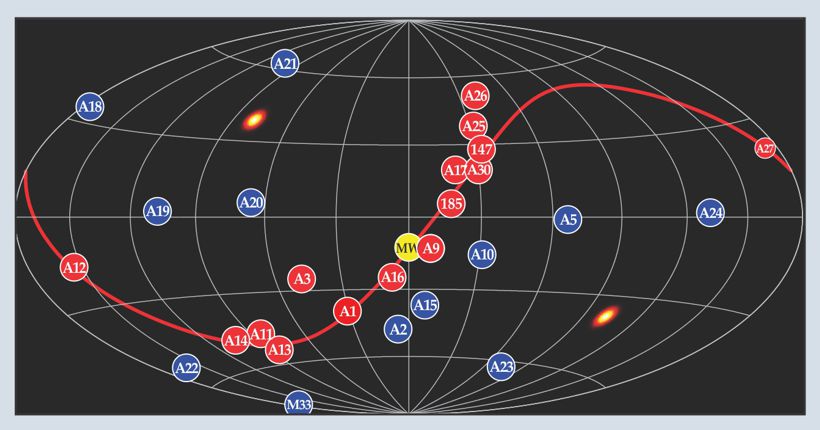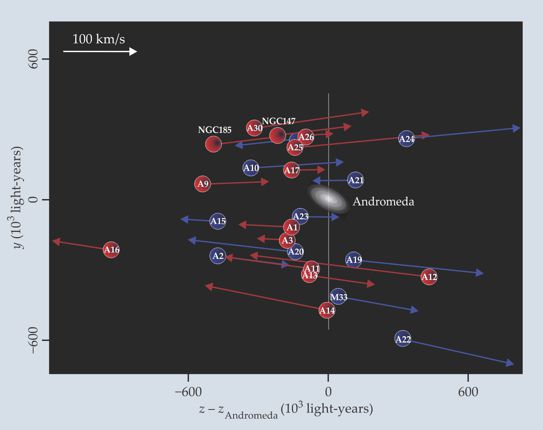Dwarf galaxies orbit Andromeda in a surprisingly thin plane
DOI: 10.1063/PT.3.1903
Since 2008 the international PANDAS (Pan-Andromeda Archaeological Survey) collaboration has been availing itself of the felicitous proximity of the Andromeda galaxy to examine relics of its formation (see Physics Today, November 2009, page 15
An important PANDAS goal has been the completion of an unbiased census of dwarf satellite galaxies within Andromeda’s halo. That task addresses the troubling “missing-satellite problem.” Dark-matter computer simulations of large-galaxy formation predict many more dwarf satellite galaxies than observers have been finding.
The PANDAS detection threshold is encouraging; at Andromeda’s distance, the team can see individually almost all red giant stars within any dwarf galaxy orbiting in its halo. Still, with the census now largely complete, the team has found only 27 satellite dwarf galaxies within about half a million light-years of the disk, far too few to solve the conundrum of the missing satellites. But in the process, PANDAS has encountered a surprise that is perhaps more problematic than the dwarf shortage. An analysis of satellite motions and very precise distances, led by Rodrigo Ibata (University of Strasbourg, France), reveals that 15 of the satellite galaxies lie in a vast, remarkably thin plane through Andromeda’s center—and that they appear to orbit the galaxy coherently. 1
That puzzling planarity constrains and even challenges standard scenarios of large-galaxy formation. In such scenarios, the prestellar stages are dominated by the gravitational interaction of nonbaryonic dark matter, which outweighs all the protons and neutrons in the cosmos by a factor of six. Massive dark-matter halos like Andromeda’s gravitationally attract and trap smaller ones as well as great quantities of ambient hydrogen gas. Individual small halos—the progenitors of dwarf galaxies—are presumed to be trapped independently, one by one, and therefore to enter upon separate, independent satellite orbits without regard to any preferential plane.
A preferential plane for star formation is eventually defined by the net angular momentum of the accumulated hydrogen, as dissipative gas interactions flatten and concentrate it into a spinning protogalactic disk. But satellite halos and ambient dark matter, impervious to that global dissipation, have no obvious reason to respect the disk plane. Indeed, the satellite plane discovered by PANDAS is inclined about 40° from Andromeda’s starry disk. And evidence from our own galactic halo, albeit much less precise, points to a plane of satellite galaxies roughly orthogonal to the disk of the Milky Way.
An exceptional view
How is it that observers can have a more precise overall picture of dwarf-satellite orbits around Andromeda than around our own galaxy? First of all, seen from our vantage point only 2 × 104 ly from its center, the orbital motion of most of the Milky Way’s satellite galaxies is predominantly perpendicular to the line of sight rather than along it. But it’s only the latter—the radial component of orbital velocity—that can easily be determined with adequate precision, by spectroscopic Doppler-shift measurements.
By contrast, one gets a much better handle, albeit still only partial, on the orbits of Andromeda’s satellite galaxies because, as seen from Earth, their radial and perpendicular velocity components are comparable. The outsider’s view of Andromeda also minimizes selection biases. An insider’s view of satellites in the Milky Way’s halo is often obstructed by our galaxy’s spiral arms or central bulge. In fact, to avoid biases due to similarly obstructed views in Andromeda’s halo, the PANDAS search area excludes a small central patch of sky that encompasses the galaxy itself.
To determine the three-dimensional arrangement of dwarf galaxies within Andromeda’s halo, one needs not only their positions on the sky but also distance measurements good to about 4%. The PANDAS team determined distances from observed brightnesses by taking the intrinsic luminosity of the brightest red-giant star in each halo to be close to the well-attested astrophysical maximum—about 100 times that of the Sun.
In figure 1, the 27 PANDAS dwarf satellite galaxies are plotted as they would appear on the sky to an unobstructed observer at Andromeda’s center. The equator denotes the plane of Andromeda’s starry disk, and the central meridian is chosen to give the direction to the Milky Way.

Figure 1. The 27 dwarf-galaxy satellites identified in the spherical halo enveloping the Andromeda galaxy. Their angular positions are plotted in Andromeda coordinates as an observer at the galaxy’s center would see them. The equator marks Andromeda’s disk plane, and the central meridian is chosen in the direction of the Milky Way (yellow). The 15 satellites shown in red all appear to be within about 5 × 104 light-years of a vast planar disk through Andromeda’s center. The red curve marks the great circle of the best-fit satellite plane, and the bright blotches indicate the uncertainty of the corresponding pole positions. (Adapted from ref.

Satellites arrayed on a plane through Andromeda’s center would appear to lie on a great circle. In the plot, the 15 satellites identified by the 3D data as being coplanar (within about 5 × 104 ly) are indeed seen to align roughly along a great circle. The 15 satellites occupy a disk a million ly wide in that plane. The team estimated that there’s only one chance in a thousand that so planar a distribution over so great an expanse would be a random coincidence.
The best-fit satellite plane is inclined about 40° from Andromeda’s equatorial plane. The evidence for a satellite disk in the Milky Way, by contrast, suggests an inclination closer to 90°. So if both of those very similar spiral giants do indeed have planar arrays of dwarf satellites, their very different inclinations suggest some indifference to the starry disk planes.
Figure 1 also shows the celestial position of the Milky Way as viewed from Andromeda’s center. Lying within 1° of the best-fit great circle, it might be regarded as a very distant and oversized outlier in Andromeda’s plane of galactic satellites. “That could well be just a coincidence,” says Alan McConnachie (Herzberg Institute of Astrophysics in Victoria, British Columbia, Canada), who heads the PANDAS collaboration. “But it should be watched for in future dark-matter simulations that take specific account of our local group of galaxies. After all, Andromeda and the Milky Way do orbit each other on cosmological time scales.”
Corotating orbits
If the coplanarity of the 15 Andromeda dwarf galaxies is not just a snapshot of an improbable momentary coincidence, the stability of such a special configuration requires coplanar orbits. “So we undertook the Doppler-shift measurements of line-of-sight velocity components to look for any kinematic coherence,” says Ibata.
Figure 2 displays that sought-after coherence. Satellite positions, relative to the Andromeda galaxy, are plotted by distance z from Earth and transverse distance y to our north. That projection of 3D positions onto the z–y plane is particularly informative because from Earth, Andromeda’s satellite plane is seen roughly edge-on, running north–south. (The interactive online version of reference shows the configuration in 3D.)

Figure 2. Line-of-sight velocity components of Andromeda’s satellite dwarf galaxies, measured by Doppler shifts. Those radial velocities are indicated by the length and direction of each attached arrow. Projected two-dimensional satellite positions relative to Andromeda’s center are given by distance z from Earth and northward displacement y. All the coplanar satellites (red) that lie north of Andromeda are receding, and all but two (one of them off-scale) south of the galaxy are moving Earthward. This correlation suggests that their orbits lie in the satellite plane and all have the same orbital sense. (Adapted from ref.

The arrow attached to each satellite galaxy in figure 2 represents the direction and magnitude of its line-of-sight velocity component, corrected for the overall bulk movement of the entire Andromeda system toward the Milky Way. And it turns out that all the coplanar satellites north of Andromeda seem to be in recession phases of their orbits, while almost all those in the south are orbiting Earthward. It’s what one would expect to see if they were all corotating in the same sense within the satellite plane. And this common orbital sense is the same as that in which Andromeda’s stellar disk spins. The Doppler-shift correlations, the team concludes, reduce the probability that’s it’s all a statistical fluke to 2 × 10−5.
Seeking an explanation
Will the new findings require major revision or just small tweaks in the standard cold-dark-matter simulations of structure formation? Such simulations exhibit a cosmological network of dark-matter filaments that serve as conduits for gas and dark-matter halos (see the article by Jeremiah Ostriker and Thorsten Naab in Physics Today, August 2012, page 43
Another possibility is that Andromeda’s coplanar dwarf galaxies were created together by tidal interactions in the merger of two large, gas-rich galaxies. Then, however, the dwarf galaxies should contain very little dark matter. But it’s known from the internal motion of their stars that they are much richer in dark matter than is the galaxy as a whole.
“All the obvious possibilities pose problems,” says McConnachie. “It remains to be seen whether models within the present standard cosmology can explain the existence of the vast, thin rotating structure we’ve seen next door.”
References
1. R. A. Ibata et al. (PANDAS collaboration), Nature 493, 62 (2013).https://doi.org/10.1038/nature11717
